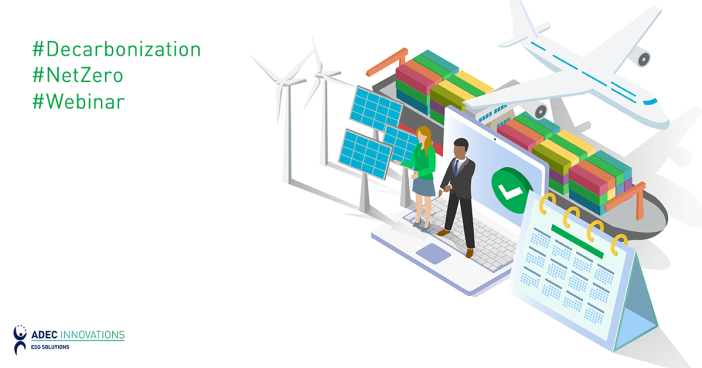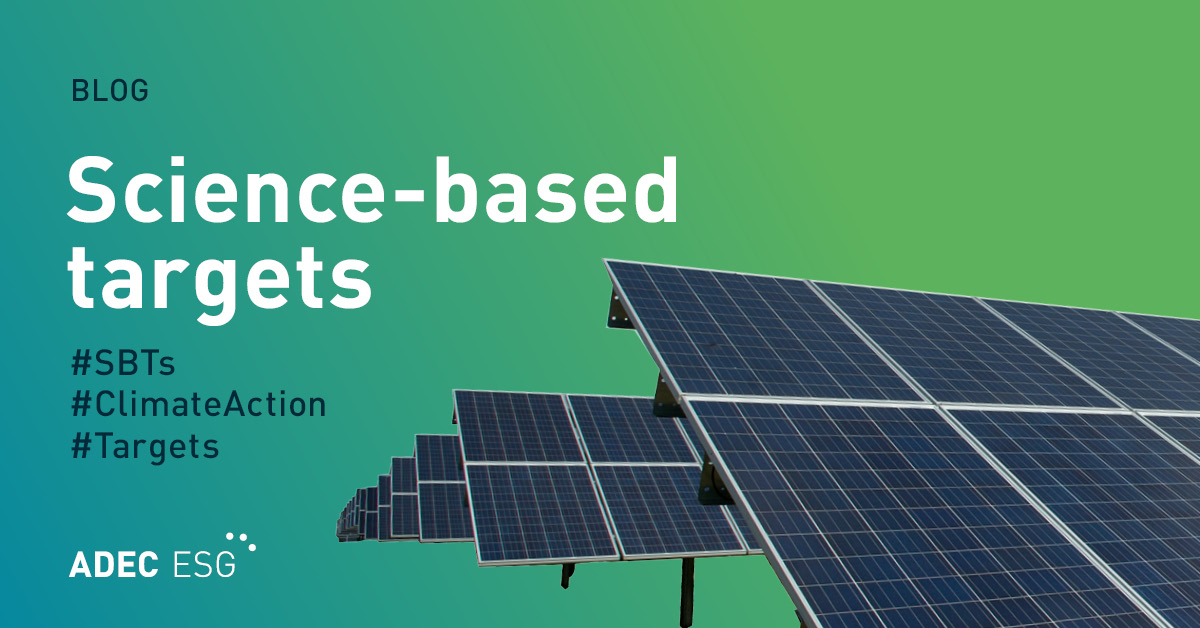The worldwide focus on a global transition to a low-carbon economy has organizations in a rush to define net-zero strategies. In a recent webinar, Streamlining Decarbonization, the ADEC ESG team broke down the process of identifying feasible strategies and creating a plan to implement decarbonization actions in the near, medium, and long term. We also walked viewers through a streamlined approach to define the options available, select those that are most appropriate, and develop rigorous and attainable implementation steps.
Put together, this process helps organizations set science-based targets, develop performance monitoring, and demonstrate progress against greenhouse gas (GHG) key performance indicators.
Watch the Streamlining Decarbonization: Key Strategies and Net-Zero Planning webinar on demand for full details, or keep reading for a quick rundown of some key points.
Decarbonization Strategy Process
The goal of this process is to identify the strategies and projects that will enable you to meet your emissions targets. For simplification, we’ve broken the process down into seven broad steps:
- Key emission source analysis
- Strategy identification
- Strategy prioritization
- Reduction pathway definition
- Developing targets or net-zero commitments
- Defining near-term implementation projects
- Long-term change management framework
Streamlining Decarbonization covers the first four of these steps, providing viewers with a systematic, actionable approach to getting started with decarbonization and net-zero goals.
Step 1: Key Emission Source Analysis
The first step in this process is a thoughtful analysis of your organization’s key emission sources. A detailed GHG emissions inventory is an essential input during this stage and applies across scope 1, 2, and 3 emissions.
Using your GHG inventory, you’ll then dig deeper to identify primary emission-generating activities, including systems, processes, equipment, and other value chain components. What are your biggest emission challenges across all these activities?
Finally, approach emissions from a corporate lens. To what degree can your organization realistically change the systems and processes that generate emissions? What control or influence do you truly have over identified emission-generating activities?
Step 2: Strategy Identification
Armed with a detailed knowledge of your emission activities, you can now begin considering and narrowing down potential strategies.
Begin by researching all available mitigation strategies for each emission-generating activity. This all-encompassing list is your starting line, a brainstorm that lays out all potential ideas on the table. From here, conduct a context analysis. Consider factors that can affect the applicability of each strategy and help you narrow down plausible strategic solutions. These factors may include company context, local environment and geography, policy and market conditions, and asset characteristics.
Last, identify the most promising emission reduction strategies, consulting with internal stakeholders to discuss the most effective and appropriate emission reduction strategies for each key emission-generating activity.
Keep in mind that mitigation strategies for one activity may not be the most effective or applicable mitigation strategy across all activities. In addition, not every strategy is ideal for every facility or every context, even across similar or identical activities. A mitigation strategy that is effective for a facility in Thailand, for example, may not be applicable to a facility that performs the same function in Mexico. The same can be true for even facilities within the same country. As always, there is no one-size-fits-all solution, and it is important to consider multiple contexts and variables.
Step 3: Strategy Prioritization
With your “wishlist” of strategies now identified, your next step is to closely and rigorously analyze each option and prioritize these strategies in a way that will best enable you to achieve your goals.
This step includes several sub-steps, including:
- Estimating the emission reduction potential of each strategy to determine maximum effectiveness, pinpointing strategies with deep reduction potential.
- Performing a cost analysis to determine the financial impact of each strategy, including an examination of CAPEX, OPEX, and transitional cost risks such as carbon taxes or price changes.
- Assessing each strategy’s technical feasibility, including how mature technologies are, how applicable the strategy is within operational and locational contexts, and whether or not the strategy aligns with your company’s culture and business model.
- Defining implementation assumptions, such as the specific technology to be used, to what degree a strategy should be implemented, and when implementation should occur.
- Reviewing and finally selecting suitable strategies, which should include extensive reviews and recommendations from subject-matter experts so that your final decision is well-informed.
Step 4: Reduction Pathway Definition
In step 4, you’ll be defining your emissions reduction pathway, taking your chosen strategies and compiling them into logical packages of strategies that can help you achieve your emissions target.
Typically, we develop multiple alternative pathways for clients, enabling us to test different goals and options and allowing stakeholders to view the pros and cons of each. We compare these pathways through the lens of multiple variables, such as emission reduction, cost, and other performance factors.
This comparative analysis facilitates discussions that lead to refining the preferred pathway, a final bundle of strategies and actions that will set you up to achieve your decarbonization goals.
Explore this step-by-step process in depth and with helpful diagrams by watching Streamlining Decarbonization: Key Strategies and Net-Zero Planning on demand.
What’s Next?
You have a chosen suite of strategies in hand and are ready to take action. What are the next steps?
Steps 5-7 of the decarbonization strategy process involve:
- Developing targets and commitments, such as science-based targets, net-zero goals, and renewable energy targets
- Defining near-term implementation projects, including project identification and prioritization, resourcing, timelines, and performance monitoring
- Developing a long-term change management framework
Although these steps occur somewhat later in the process, it is still essential that you make a start as early as possible, as they may take considerable time to develop, approve, and complete. Targets submitted to the Science Based Targets Initiative (SBTi), for example, must be developed to meet specific SBTi criteria and be officially validated by the organization. Achieving ambitious decarbonization goals can also require substantial change within your organization, from strategy and culture to company structure and capacity-building, and starting to think about developing a change management framework early on puts you in a much better position to successfully navigate those changes.
Want more than the highlights? Watch the full Streamlining Decarbonization webinar on-demand to get the details from our experts.
ADEC ESG Solutions is a leading provider of sustainable solutions, with expertise in delivering fully-integrated consulting, software, and data management services. Talk to us today to learn more about how we can help you build towards your decarbonization or net-zero goals.




